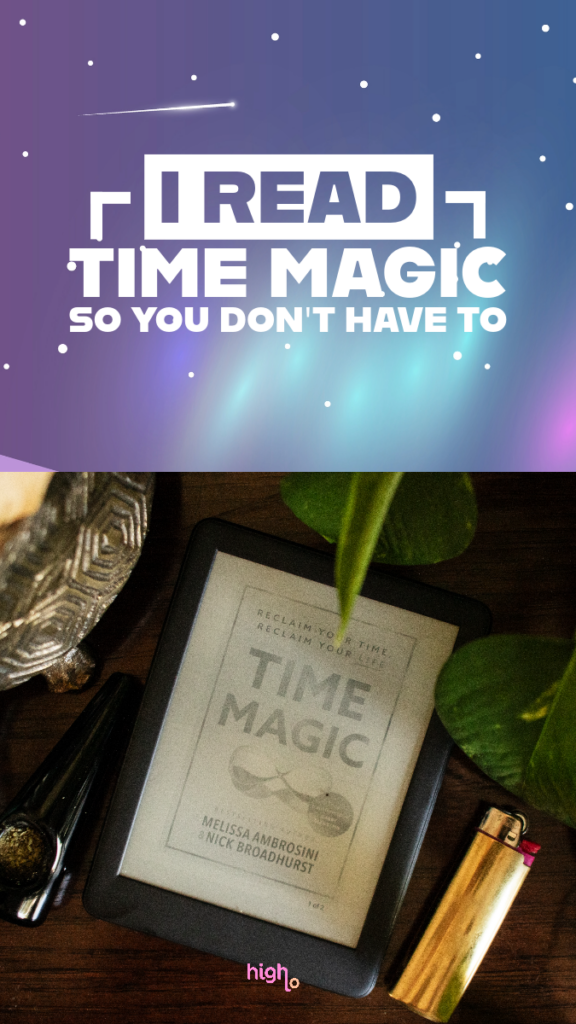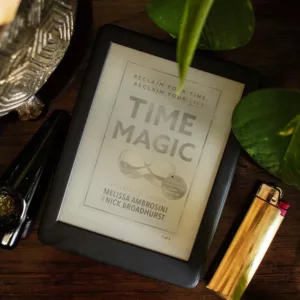As I begin my journey into mid-life, I have found myself turning towards growth and overall health more and more. For me, part of health is making sure my mind is clear, I’m accomplishing goals, and I don’t feel overwhelmed while doing everything I want and need to do. So when I was browsing through new ebook releases in my local library’s catalog and saw a book promising to teach me to “reclaim [my] time, reclaim [my] life,” I figured fuck it. And I threw it on my holds list.
Honestly, I figured it’d be one of many books I’ve abandoned over the years that fall into a similar “self-help” category. But I was pleasantly surprised when I finished it in a few days (other more fun books took precedence, and suddenly, I had three days before the library kicked me back onto the waiting list). That’s not to say “Time Magic” by Melissa Ambrosini (and technically her husband too, but something tells me she did most of the work) was this incredible masterpiece and revolutionary. Not by any means. I think I’ve entered a phase where I can read anything when I just have to see where this is going. I’ve read many bad books this year, and I would put this one somewhere around the bottom half of the middle.
It wasn’t a complete waste of the six hours I spent reading it, but I don’t know if I’d recommend you read it. Instead, let me divulge the most significant points, and you can take it from there. I do think that this book can be helpful if you don’t know how to manage your day-to-day life and need a clear-cut system for getting things done around your home and work and still maybe find a moment here and there for activities you love — if the things you love are things that can easily be picked up and put down and not giant long term projects that might need a few dedicated hours at a time.
Indeed, I think this book is most beneficial for someone who works from home and doesn’t have kids (or can afford to hire help to manage the kids) and has no clue how to go about a day when you’re the one left in charge of how to schedule your day. Does that make sense?
However, you must remember that this book is written by two incredibly well-off people who can afford to hire someone to manage their emails, work with trainers and nutritionists, and work from home. Their reality is out of touch with most of the general population — with most of their audience, I’d imagine. It’s a lifestyle handbook as much as it’s a book about managing your time… or reclaiming your time, as it were. Keeping their lifestyle in mind while reading this book will help minimize how much your eyes will roll back into your skull so hard they may detach and roll away just so they can look back at you and ask, “Why? Why are you doing this to me?”
Am I being mean? Sorry, Melissa! It’s not your fault. And to be fair, the author(s, allegedly) mentioned recognizing their privilege more than once throughout the book. And I do believe that they recognize their privilege. But what does recognition mean? I recognized it too just by reading the book; that doesn’t help Christine, who has three kids and works four jobs between her and her partner. I mean… how much time do you really think Christine is wasting on social media? The girl can’t even sleep 6 consecutive hours without risking arriving late to work.
I also found their view on rest just silly. I mean… they said that rest is essential and used all the right words in that regard, but rest is rest. Rest is not doing shit. Rest isn’t picking up a baking hobby or even doing yoga or anything else that requires repetitive or meditative movement. They seemed incredibly careful to avoid saying take a nap, which is quite frankly what many folks need. “You won’t need a nap if you’re doing all the other things in this book, like sleeping well and eating boring bland food like we do!” Nick cries as he reads this. He’s not reading this, but I can pretend he has a Google alert for the title of “his” book– excuse me, their book. (whispers he’s just Ken, let him go to some little mojo dojo casa house).
This book is for stay-at-home sports moms whose kids are about to be or are in middle school and suddenly want to start a podcast to talk shit about the other moms in town because their kids are about to despise them for the next decade. No average person is reading this book and thinking that all, or even most, applies to or is attainable for their life.
If I had known that there is a whole section about increasing longevity through eating healthy food, I probably wouldn’t have read the book in the first place. To be honest… fucking no shit. I just find the people who push plant-based lifestyles to be annoying. It’s not practical.
But that’s not to say I found nothing of value in this book. As I mentioned at the beginning of this review, I am in a phase of reprioritization in my life. This helped me realize how much time I spent on things that didn’t matter to me (like the biggest one, for most of us, social media).
This book outlines how many hours, days, weeks, months, and years one might spend on various activities, like work or being on your phone. For example, spending four hours daily on social media for the next 40 years would equal almost seven years. If you live another 40 years, would you want to have spent nearly 20% of it on social media? If it’s where your community is, do you want to spend more? And further, how are you spending your time there? I think that this book helped me both think of and answer those questions. And what other activities do I turn to when I’m procrastinating?
Their idea of investing time and compounding interest with better activities intrigued me. The lists of easy, low-energy tasks and replacement 5-minute “break” activities will help me replace some of the mindless scrolling that I tend to do (and ultimately just leads to me feeling bad). They called these activities smoothies, which was a little cringe, but I understood the metaphor.
They have a much more stringent and out-of-touch view of phone use in general. I got the impression that they believed that smartphones are essentially useless. Still, since I’m not an out-of-touch loon, I know that for most people, their smartphones might be the only device that connects them to the internet and services, and you can’t completely cut out all phone use. But I would follow their recommendation to turn on screen time limits for social media apps and other time wasters. Check the stats on your phone (Google it, come on, you should know your own phone) and see where you spend the most time on your phone, and I bet you’ll find some places where you could use it a little less.
Another thing I found insightful was to leverage your energy levels. It’s something I’ve heard recommended before on plenty of life-hacking blogs, but what I hadn’t seen along with those recommendations was a practical way to do that. In “Time Magic,” the authors suggest building a list of tasks that take a small amount of energy. When you’re unsure what to do, boom, there’s a list of suggestions you can turn to. They also have a similar activity in the social media section of the book. Still, it’s for easy tasks that you can do to replace mindless scrolling. These lists were so clever, and I was a little pissed off that I had to learn them from this book.
They did use that overplayed rock analogy (maybe it’s just starting to make the rounds in Australia? idk) to go into a whole thing about how they set up their calendar and task manager apps and prioritize their goals, hobbies, and to-dos. They rely heavily on the fact that you’ll gain all this extra time if you just don’t use your phone and use this calendar system.
They instruct the reader to list everything they want, need, and would like to do daily. This list can include things like “call my siblings more,” “do the laundry,” and “run the tps reports at work.” Literally all of the things you need or want to do. They recommend using a fancy task manager app, but you can do it on your phone’s free reminders/task app. The tasks are dumped into a general inbox list and then siphoned into separate lists or groups (whatever your task app uses to categorize tasks). You add due dates, and if it’s something you do regularly, add the details for how frequently the task reoccurs (obviously).
When setting up the calendar, you basically want to fill in all the time you’re not sleeping, working, or eating with the activities/tasks you outlined as priorities in your newly minted task list. And then, every day, you’ll spend a few minutes organizing your tasks and adjusting your schedule as needed. Of course, this works best if you remember to add tasks to the inbox as you think of them. It’s not as easy of a job if you’re not already using an app for task management as it sounds.
The authors seem more focused on productivity than I personally am. Still, I can see how these principles can be applied so that you’re spending more time engaged with your family and loved ones and in activities that nourish you rather than filling you up with junk or making you feel like you are wasting your time. That means investing more in one-on-one relationships both IRL and online, making more time for art, and limiting my time scrolling through Instagram, TikTok, and the artist formerly known as Twitter.
I recommend borrowing it from your local library if you want to read it. While I found some helpful information in there, they oversold the book. Any book that spends as many words as it did telling the reader just how different and unique the book is probably isn’t worth reading. If the book is that unique and different, I’ll know by reading it. Show me, don’t tell me, you know?
This is my first time reviewing a book, so I haven’t quite figured out the rating system, but since this has traditionally been a weed-centric website, let’s give it 2 out of 5 pot leaves.




